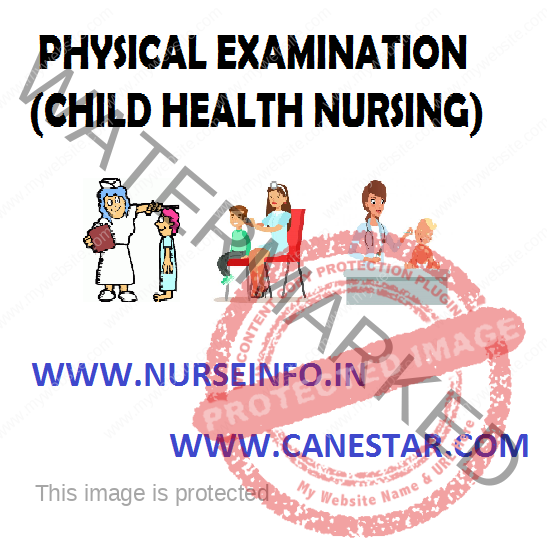PHYSICAL EXAMINATION – Purpose of Physical Examination, Techniques of Physical Examination, Guidelines of Physical Examination, Equipment Needed and Measuring of Vital Signs in Children (CHILD HEALTH NURSING)
Physical examination is a skill used by nurses to examine and monitor sick children, undertake diagnostic investigation and provide therapeutic interventions
PURPOSE OF EXAMINATION
- To differentiate normal from abnormal physical findings
- It helps to give important information about growth and development
- Physical assessment skills are used to assist in making clinical judgments about a client’s health status and evaluating the effectiveness of nursing and medical interventions.
TECHNIQUES OF PHYSICAL EXAMINATION
There are four primary techniques used in physical assessment.
- Inspection: It is the systematic, deliberate visual examination of the entire client or a region. Inspection yields information about size, shape, color, texture, symmetry position and deformities.
- Palpation: Examination done by the use of touch. Palpation yields information about masses, pulsation organ size, tenderness or pain, swelling, tissue firmness and elasticity, vibration, crepitation, temperature, variation in texture and moisture.
- Percussion: Is a technique in which sound is produced by striking the child’s skin in order to assess the underlying area. Percussion of body structures containing air, fluid and solids produces various sounds, depending on their densities.
- Auscultation: It is listening to internet body sounds in order to assess normal sounds and detect abnormal sounds. There are four sound characteristics the nurse notes when auscultation – pitch, intensity, duration and quality.
GUIDELINES FOR PHYSICAL EXAMINATION
- Physical examination proceeds in a logical, orderly fashion. The approach commonly used by examiners follows a head to toe system of organization so that findings are complete. Successful physical assessment requires the nurse to be knowledgeable of both the techniques and the parameters of normal client findings.
- Preparation of the environment includes private, quiet and comfortable position. The environment is neither too warm nor too cool.
- Preparation of equipment is assembled and available before the examination is begun. The nurse practices picking up equipment, holding it in the position of used, making adjustments and assembling and disassembling.
- Preparation of the client: The examination begins with a child on parent’s knee. Prepare the infant and parent physically and psychologically for the physical examination.
EQUIPMENT NEEDED
Equipment used for physical examination are thermometer, oto-ophthalmoscope, tongue depressor, lubricant, stethoscope, reflex hammer, disposable gloves, cotton applicator stick, tuning fork and flashlight.
MEASURING OF VITAL SIGNS IN CHILDREN
Temperature
- Oral temperature is considered as the reference temperature and is taken by placing the clinical thermometer under the tongue.
- In children below 5 years, skin temperature or rectal temperature can be taken. Never leave the child alone when taking temperature.
- For security, safety and accuracy keep one hand on the thermometer when it is in place and record in the chart.
Pulse
- The pulse should be recorded when child is at rest or during sleep. Crying, activity and anxiety may increase the pulse rate.
- Radial pulse is usually recorded by placing middle and index fingers gently over the outer side of forearm just above the wrist. It should be recorded for full one minute by watch.
- Record accurately the following – rate, rhythm, strength of beat and activity of child at time pulse is taken. Record and report immediately if there are any changes in the pulse.


